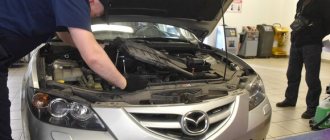Audi cars are one of the most desirable representatives of the secondary market. There are several reasons for this interest: the high durability of many models, pleasant finishes, good equipment and excellent technical data. But when choosing a used “car with rings”, you should be careful.
Firstly, low prices are often a harbinger of low mileage or hidden defects. Secondly, parts and repairs are often expensive. Even if nothing breaks, maintenance costs will be high. At the same time, with the increase in the Audi class, the cost of ownership increases like an avalanche.
If the Audi A3 is not yet so expensive to maintain, then the Audi A6 may turn out to be unaffordable. It's all about a more complex suspension, electronics and a tightly packed engine compartment.
Both petrol and diesel engines can generate unexpectedly high costs. Among gasoline units, a breakthrough occurred in 2007. Then the 1.4, 1.8 and 2.0 TFSI came under the Audi hood. At the same time, numerous troubles arose: the timing drive failed, oil wasted, pistons were destroyed. The V6 deteriorated somewhat earlier when the fast and robust 2.4 was replaced by the 2.4 FSI.
The story in the diesel branch is no less complicated. An example of this is the successful 1.9 TDI and the failed 2.5 V6 TDI (the latest versions of which, for example, BAU have already been practically freed from the defect). Then came the unsuccessful 2.0 TDI PD with pump injectors and the decent 3.0 TDI V6. Later, the 2.0 TDI PD was replaced by the improved 2.0 TDI CR with common rail injection system.
Diesel engines
1.9 TDI – durable and economical
This is the most recognizable diesel engine of recent years. Even an older Audi with a 1.9 TDI is worth a look - robust construction and inexpensive repairs.
1.9 TDI is a legend engine. Produced since 1991 and modernized many times. It has found its way into many other VW Group vehicles.
The 90-horsepower version with a distribution-type injection pump is recognized as the most reliable and cheapest to operate and repair. The engine has a simple design, a constant geometry turbine and a single-mass flywheel.
Yes, minor problems happen sometimes. For example, with an exhaust gas recirculation valve, an air flow meter and a fuel pump. But for the most part, malfunctions are caused not by design flaws or poor quality, but by considerable age and high mileage.
The younger and more powerful versions of the 1.9 TDI have introduced more solutions that can create problems. We are talking about a variable geometry turbine, a dual-mass flywheel, pump injectors and a DPF. However, even these versions appear in a more favorable light against the background of diesel engines.
The exception is the 2006-2008 BXE version, which fell, for example, under the hood of the second generation Audi A3. There are many cases of bearings turning after 120-150 thousand km.
Advantages:
- simple design;
- good endurance;
- low fuel consumption.
Flaws:
— many worn-out copies (the engine was installed until 2009, and since 2004 it was gradually replaced by a 2-liter turbodiesel);
— low work culture: noise and vibration, especially after starting a cold engine.
Application examples:
— Audi A3 I (8L) and II (8P);
— Audi A4 B6 and B7;
— Audi A6 C4 and C5.
2.0 TDI CR – everything is finally good
A 2-liter diesel engine is the main unit for most Audi models. Since 2007, he began to use the Common Rail injection system.
The design flaws of the 2.0 TDI with unit injectors prompted Volkswagen engineers to thoroughly modernize it. Changing the way we eat is the most important new thing. The pistons were also updated, problems with the oil pump drive were eliminated, a new cylinder head and camshafts were installed. As a result, engine durability was significantly improved, but disadvantages also appeared.
When buying an Audi with a 2.0 TDI engine, you should check the car's history. Often, these were cheap and economical versions purchased for commercial or corporate garages. They have huge mileage and have not always been well maintained.
Typical faults affect the dual-mass flywheel and turbocharger. Piezoelectric injectors fail here no more often than their competitors. Fortunately, they can be restored. As part of the service campaign, the manufacturer replaced the high-pressure lines.
Advantages:
— good performance with acceptable fuel consumption;
— good durability (especially in comparison with 2.0 TDI PD);
- a wide variety of versions.
Flaws:
— expensive maintenance (complex design and expensive spare parts);
- significant mileage of many copies, despite their relatively young age.
Application examples:
— Audi A4 III (B8);
— Audi Q5 (8R);
— Audi A6 III (C6).
3.0 TDI – for the demanding
High performance and dynamics are not the only advantages of the 3.0 TDI. Therefore, many choose it with pleasure, even despite the fairly high maintenance costs.
The 3-liter turbodiesel was designed to correct the bad reputation of Audi V6 diesels, spoiled by the 2.5 TDI V6. The 3.0 TDI earns respect not only for its performance, but also for its durability. The block, cylinder head and crank mechanism turned out to be very strong. There are 4 valves and one piezoelectric injector for each cylinder.
The problems mainly concern equipment. The most common problem is the timing drive, the replacement cost of which is very expensive. Before 2011, 4 chains were used, and after - two. The drive chain is located on the gearbox side. To replace it, you have to remove the engine.
The flap in the intake manifold (repair kits are available for sale) and the DPF are not free from shortcomings. The engine is constantly being improved, and in later versions malfunctions are much less common.
Advantages:
— high work culture;
— good performance;
— low fuel consumption;
- good service life of many engine parts.
Flaws:
- expensive to troubleshoot timing belt, intake manifold and DPF faults;
— many copies on the market have high mileage and questionable technical condition.
Application examples:
— Audi A5 I (8T/8F);
— Audi Q7 I (4L);
— Audi A8 II (D3).
Audi 4.0 tfsi engine repair
CEUA engines; CTGA; CTGF; CGTA; CTFA; DDTA; CRDB; CWUB; CWUC; CEUC; CTGE
Today, the Audi 4.0 tfsi engine is one of the most reliable 8-cylinder engines and at the same time one of the most difficult to repair.
The main reasons for contacting our technical center are increased oil consumption, noisy operation of the AUDI 4.0 engine, and engine seizure.
The first place to start diagnosing a 4.0 tfsi engine is endoscopy of the cylinders. Using this tool, you can evaluate the condition of the cylinder-piston group, the condition of the valves, the combustion chamber, and even the geometry of the connecting rod rod!
The main defect in which a major overhaul of the AUDI 4.0tfsi is inevitable is scuffing of the cylinder walls. There are several reasons for this: low-quality oil is unable to maintain a guaranteed oil film to avoid semi-dry and dry friction of the piston against the cylinder wall, local overheating of the cylinder wall due to a faulty fuel supply system or its low quality, faulty cooling system, foreign particles entering the cylinder in the form of solid ceramics from a deteriorating catalyst or flying coke from the intake valves, which always have natural deposits due to the fuel being supplied directly to the cylinder.
The next defect is increased oil consumption due to wear of the valve guides. The main weak point of the Audi 4.0 tfsi cylinder head is the valve guides; they wear out a lot even with low mileages, this is due to the quality of materials and the rocker valve opening system (there is always a lateral load on the valve stem). With severe wear, the valve in the guide begins to “warp”, the oil seal stops sealing the rod and oil is sucked out between the guide sleeve and the valve at the time of the intake stroke. Solved by replacing the valve guides. The valves are also tested for stem wear and valve disc runout; valves that have passed the test are cleaned of carbon deposits and coke.
Noisy operation of the AUDI 4.0tfsi timing belt due to chain stretching, wear of tensioners and dampers, insufficient oil pressure (all chain tensioners are hydraulic) or wear of phase shifters. It is worth noting here that if this engine goes to specialists who have not dealt with it to replace the phase shifters, then in 99% of cases the phase shifters will be installed incorrectly, because the original ELSA technical documentation does not indicate the position of the phase shifters relative to the camshaft at the time of timing belt installation, and the technician will install them as on the 4.2-liter engine of the previous generation; in this case, the noise will not disappear.
Restoration of the Audi 4.0 TFSI cylinder block.
When restoring a cylinder block, we use a liner; this is the most reliable way to forget about the problem of scuffing once and for all. Because The 4.0 tfsi engine is currently one of the most popular among tuning enthusiasts; we have worked out and tested options for boosting the AUDI 4.0 tfsi engine to 1300 hp. and we can safely say that after our sleeve the engine becomes more reliable than the factory one!
The MensMotors technical center has its own machine park and experience in restoring engine parts for more than 20 years, this is of fundamental importance when clients choose our organization, because We provide a guarantee on all work, including restoration of parts and used spare parts, for up to 2 years.
Risky choice!
Audi's range includes engines that are great in theory but painfully disappointing in practice. In particular, mention should be made of the first generation 1.4 TFSI with a problematic timing chain drive. Currently, a more reliable version with a timing belt drive is used.
The 1.8 and 2.0 TFSI engines with the code designation “EA888” are tempting with their high output. However, they suffer from high engine oil consumption. There are also problems with the turbine, camshafts and electronics.
There are also black sheep among diesel units. For example, the Audi A2 was equipped with a 1.4 TDI with pump injectors. The problem is the appearance of crankshaft play, the elimination of which is not economically feasible. The 2.0 TDI PD is known for its cracking cylinder head and poor equipment durability. The 2.5 TDI V6 is plagued by numerous mistakes with the timing belt, as well as with the lubrication and power system.
Engine 2.0 TDI (150 hp) characteristics, fuel consumption, dynamics
- Working volume – 1968 cm3
- Number of cylinders – 4
- Number of valves – 16
- Power hp – 150 at 4200 rpm
- Torque – 320 Nm at 1750-2500 rpm
- Type timing/timing drive – DOHC/belt
- Maximum speed – 210 km/h
- Acceleration to 100 km/h – 9.1 seconds
- Fuel consumption in the city – 5.7 liters
- Combined cycle - 4.8 liters
- Fuel consumption on the highway - 4.4 liters
There is not much information about the design of the 3-liter Audi A4 diesel engine. Therefore, we will limit ourselves to the main characteristics.
We carry out repairs and maintenance of all Audi models
We provide repairs and maintenance of Audi
, all models and different years of manufacture.
| Car models Audi with whom we work | |||
| A3 | A4 | A5 | A6 |
| A8 | Q3 | Q5 | Q7 |
Audi engine diagnostics are trusted by RF Motors
The RF-Motors car service center is equipped with professional equipment for high-quality computer diagnostics and engine repairs. Competent specialists of our service have enough skills and experience to carry out such events. After diagnostics, we will accurately determine the source of the malfunction, without removing the internal combustion engine from the vehicle.
You can contact the service center not only if there is a serious breakdown, but also for preventive maintenance or pre-sale preparation of the car. To carry out diagnostics, you need to bring the car to our service center.
Audi engine diagnostics
, in our car service center, is carried out by an experienced specialist. The car service technician will conduct a full diagnosis and, if a malfunction is found, will offer options for eliminating it. All necessary repair work can be carried out immediately in our box. A serviceable car is the key to your safety on the road.
Reviews
Nikolay (Gelendzhik), Audi 200 (1987, 2.2 liters, petrol)
The main problems of the car include the turbocharged engine. As soon as a small breakdown occurs in the air injection system, the car stops. Not everyone can deal with the problems of this engine on their own, which means they need to pay specialists.
I was pleased with the spacious interior and high level of safety. The car is heavy, more than 1.2 tons. During operation and maintenance I encountered problems with the uniqueness of some components. An example is car headlights, which are almost impossible to find in Russia.
In general, there are a lot of original spare parts, which greatly increases the cost of maintenance. Due to the age of the car, the mechanical injection system began to act up. Because of this, fuel consumption increased to 20 liters per 100 kilometers. It is highly recommended to fill in AI-95, since with 92 you will get additional problems. Vladimir (Lyubertsy), Audi 200 (1989, 2.2 liters, Quattro)
I bought the car in 2000, when it was a little over 10 years old. If you buy this car, remember that you need to be a fan of the brand and know the car. Otherwise, during operation, the problem will pile on top of the problem. I didn’t experience any particular problems with the suspension, since it was made to last.
With the help of all-wheel drive, I drove through our snow-covered yards without any problems. Although the car, of course, is not suitable for serious off-road adventures due to its low ground clearance. And, in general, it was not created for this.
For the first 5-6 years of operation, I didn’t have any problems with the car. But then everything began to crumble. There were problems with the on-board computer, brakes and ABS, starter, climate control, etc. We had to go through a lot of things in the car. Subsequently, he sold it to a person who found it easier to maintain it. I still sometimes see this car in the city.
Mikhail (Ufa), Audi 200 (2.2 liters, 1990)
I purchased the car at the age of 12 years and 200 thousand mileage. For the most part, I used the car on long-distance trips on the highway, and not in the city. During the first year of operation, I spent approximately 40-50 thousand rubles on eliminating various malfunctions and shortcomings.
For example, the release bearing, GTC, spark plugs, electric windshield wiper motor, rear brake pipe, steering rack damper, etc. were replaced. The air conditioner was especially problematic, which was repaired 3 times. The ride on the highway is excellent. The car is very dynamic and goes along the road like a locomotive on rails. Gasoline consumption outside the city is approximately 12-14 liters per 100 kilometers. In the city, no less than 15-17, and often reached 20 liters per 100 kilometers.
Otherwise, I would like to note the excellent leather interior, the spaciousness inside the car, convenient controls and ergonomics. In places of seams, as well as various body elements, the paint gradually peels off due to corrosion. But there are no through holes anywhere, despite the considerable age of the car.
The main signs of an Audi engine malfunction
Quite often, especially for novice drivers, it is very difficult to understand that the engine requires repair. The following main signs will help determine that the engine is malfunctioning:
- Warning indicators light up on the instrument panel;
- Unstable engine operation is observed: jumps, twitching and oscillations;
- An uncharacteristic sound appeared under the hood: shots, clicks, crackling and rumble;
- There was a smell of exhaust gases in the car interior;
- Thick smoke or excessive amounts of steam are coming out of your car's exhaust pipe.
If you notice unstable engine operation, or your car has at least one of the listed symptoms, then you should contact a car service for diagnostics. Timely contact with specialists will prevent the failure of the entire unit. Ignoring problems will lead to expensive repairs.
To accurately determine the breakdown and its location, our specialists carry out computer diagnostics of the engine.











